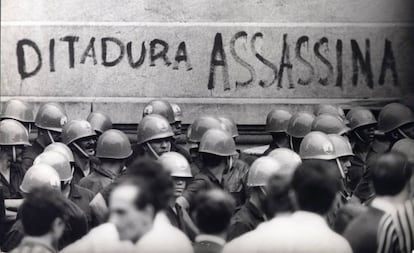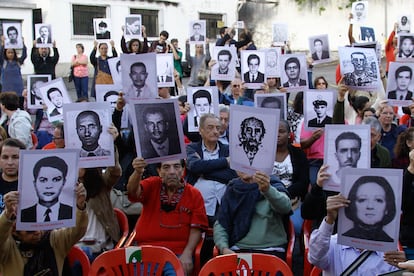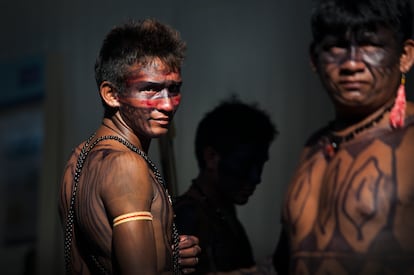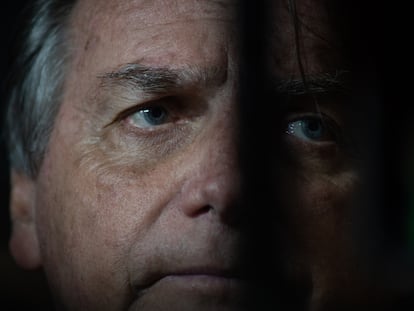Brazil’s dictatorship: Repression, torture, slaughter of Indigenous people and censorship
Sixty years have passed since the 1964 military coup, an event that current President Lula would rather not mark with any ceremony so as not to further strain his relationship with the military


On the night of March 31, 1964, the Brazilian military deposed the legitimate president, the leftist João Goulart, in a bloodless coup. A dictatorship began that would last more than two decades. In the midst of the Cold War, the elites were furiously anti-communist and Goulart promised agrarian reform and public policies for the working class. Four years later, the generals closed Congress and toughened repression through Institutional Act number 5. Brazil would not return to democracy until 1985.
For the many supporters of the coup, it was a revolution so that Brazil did not fall into the clutches of communism, in an interpretation of the constitutional breakdown backed by far-right ex-president Jair Bolsonaro. During his presidency, the 1964 coup was officially celebrated in the military. The current president, the leftist Luiz Inácio Lula da Silva, wants the events of 60 years ago to be marked with a low-key anniversary so as not to ruffle any feathers in the Armed Forces. The president is treading carefully, as Bolsonaro and several military officials have been accused of plotting a coup in the most serious attack on democracy since the end of the dictatorship. Their alleged actions indirectly resulted in the assault on the headquarters of the three branches of government in Brasília in January 2023.
This is a review of some of the key moments from the military regime and the transition to democracy.
The Truth Commission

The Truth Commission published the official account of the dictatorship in 2014 after listening to victims and witnesses and holding public hearings. The report holds the regime responsible for 434 deaths and missing persons, in addition to documenting the systematic practice of arbitrary detentions, torture, executions, and forced disappearances. And it also left for posterity the names of 377 instigators and participants in the repression. The amnesty law that exempted them from sitting on the bench freed thousands of political prisoners. One of the most infamous torture centers in São Paulo was converted into the Memorial da Resistência center.
The 1,300 pages of the final report include shocking passages such as the testimony of Isabel Fávero: “On the third or fourth day of being imprisoned I began to feel like I was having a miscarriage — I was two months pregnant. I was bleeding a lot, I had no way to clean myself. I used toilet paper, and I already smelled bad. I was dirty, so I think — I’m almost certain — that they didn’t rape me because they constantly threatened me. I disgusted them. (…) Surely it was that. They got angry when they saw me dirty, bleeding, and smelling bad, and that made them even more angry, and they hit me even more.”
Murder of Indigenous people

The Truth Commission did not include Indigenous people in the official number of those murdered by the dictatorship, but it did record that at least 8,350 died due to the acts or omissions of state agents between 1946-1985. They killed them to plunder their lands or to evict them. They died from contracting diseases they had not been vaccinated against and from torture and mistreatment in prison. With thousands of deaths each, the towns of Cinta-Larga and Waimiri-Atroari were the most affected.
The most detailed information about the ruthless persecution of Indigenous people at that time is an official report prepared in 1967 and which was missing for almost half a century. The Figueiredo Report concluded that “withholding assistance is the most effective way to commit murder. Hunger, plague, and mistreatment are decimating brave and strong people.”
After traveling nearly 10,000 miles, prosecutor Jader de Figueiredo prepared a chilling document of more than 5,000 pages that took his name. “The Indian Protection Service has degenerated to such an extent that it persecutes them to the point of extermination,” he wrote. The military’s policy to clear the Amazon included machine-gunning from the air, launching explosives, smallpox inoculation, and donations of sugar mixed with strychnine. In 2013, a researcher, Marcelo Zelic, rescued the report from oblivion in the government archives and disclosed its brutal content.
President and survivor of torture

Dilma Rousseff went down in history as the first female president of Brazil in 2011, but what is not usually mentioned is that she was the first head of state that was also a survivor of state-sponsored torture during the dictatorship. It was she who created the Truth Commission in 2012, a decision for which the military did not forgive her.
A far-left militant, she never fired a single shot, but that did not save her from going to prison for three years in her early twenties (between 1965 and 1968). She suffered torture sessions that marked her forever, both physically and psychologically. They beat her so severely that her jaw was dislocated and several of her teeth were knocked out. “The torture marks are part of me. They are me,” she testified in 2001 before a commission that managed compensation for those who were retaliated against. “The worst thing about torture was the waiting. Waiting to be beaten,” she revealed.
At the worst moment of her political career, when Congress was voting on her impeachment, then-deputy Jair Bolsonaro, a historical revisionist and retired military man himself, voted in favor of impeachment in honor of Rousseff’s torturer, Colonel Carlos Alberto Brilhante Ustra.
Lula from A to Z

The biography Lula, by Fernando Morais, recalls that the current president did not think badly of the military when they came to power in 1964 to restore order. But he was not spared from going to jail either. When he stood for election for the first time in 1989 — while the country was in its transition to democracy — the Air Force intelligence service developed a glossary, published recently by the newspaper Estadão. In it, authorities had gathered statements from Lula, so that those in the barracks knew who this unionist was who had fought against the dictatorship. The confidential report concludes that “the charismatic union leader has acquired a political personality in the [Workers’ Party] and, leading a fierce and noisy party, has drawn up more daring plans.” Lula lost three presidential elections before winning in 2002.
Subversion of censorship with Camões
In 1972, censors arrived at the Estadão editorial office. They reviewed the news and editorial content that would go into the next day’s print edition. They erased anything that bothered the regime. As usual in dictatorships, what was striking was the newspaper’s reaction. Its staff refused to change the design and resorted to ingenuity. Every time a news item or an opinion column was censored and, therefore, left a gap in the printed paper, they would fill it with verses from Os Lusíadas, by the celebrated Portuguese poet Luís de Camões. The idea was put forward by António Carvalho Mendes, the journalist in charge of the paper’s film and obituaries sections.
The first verse replaced a news story about the episcopal conference and Pedro Casaldáliga, the so-called “bishop of the forgotten” and preacher of liberation theology. They published verses from the great epic of Camões 655 times.
It is forbidden to forbid

When Jair Bolsonaro won the elections in 2018, Caetano Veloso released a list of songs on Spotify that included É Proibido Proibir (Forbidden to Forbid), composed half a century earlier in the wake of the May 1968 protests and in the leaden years of the Brazilian dictatorship. Brazilian popular music and the guitar rock that came from the United States fought a tough duel when Caetano sang it at a concert in São Paulo that ended with loud boos. The composer and singer burst out with a “you don’t understand anything!” followed by a speech against the conservatism of the public.
At the end of that year, President-General Artur Costa e Silva passed Institutional Act Number 5, known in Brazil as AI5, which shuttered Congress and consolidated the dictatorship. Days later, Caetano Veloso and Gilberto Gil were arrested, banished to Bahia months later, and then sent into exile that took them to London.
O Globo and the ‘mistake’ of 1964
In 2013, the newspaper O Globo — part of Grupo Globo, Brazil’s largest media group — published an editorial titled Editorial support for the 1964 coup was a mistake. It recalled the text that “O Globo agreed with the intervention of the military along with other large newspapers, such as O Estado de São Paulo (known as Estadão) and Folha de S.Paulo, among others. “A large part of the population did the same, with express support in demonstrations.” The editorialist concludes that “in light of history, there is no reason not to recognize explicitly today that the support was a mistake (…). Democracy is an absolute value. (…) Only [democracy] can save herself.”
The newspaper claimed that this conclusion was the result of years of internal discussions, but the definitive decision to publish it, specifically in August 2013, was the massive demonstrations against everyday politics and a chorus that shouted: “The truth is hard, Globo supported the dictatorship.”
Party to bury censorship
On July 29, 1985, at eight in the evening, some 700 artists and intellectuals gathered at the Casa Grande Theater in Rio de Janeiro to hold a funeral for censorship. The new civil government had been in office for three months. The Minister of Justice had called them to make it official that the persecution of culture that displeased the military was at an end. The fearsome censor Solange Hernandes, who silenced 2,500 songs, would have to focus her ire on something else because the minister declared censorship extinct and announced that from then on a council in defense of freedom of expression would study books, records, plays, and soap operas to classify them by the age of their intended audience.
Sign up for our weekly newsletter to get more English-language news coverage from EL PAÍS USA Edition









































